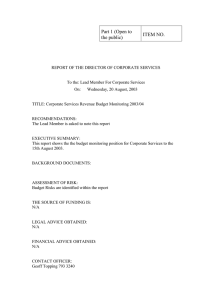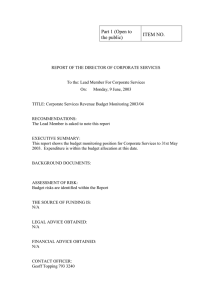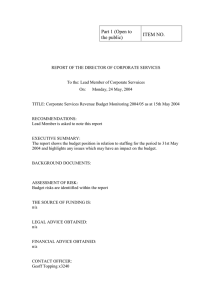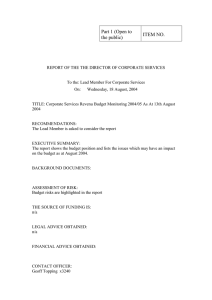035300 – non –structural concrete topping
advertisement
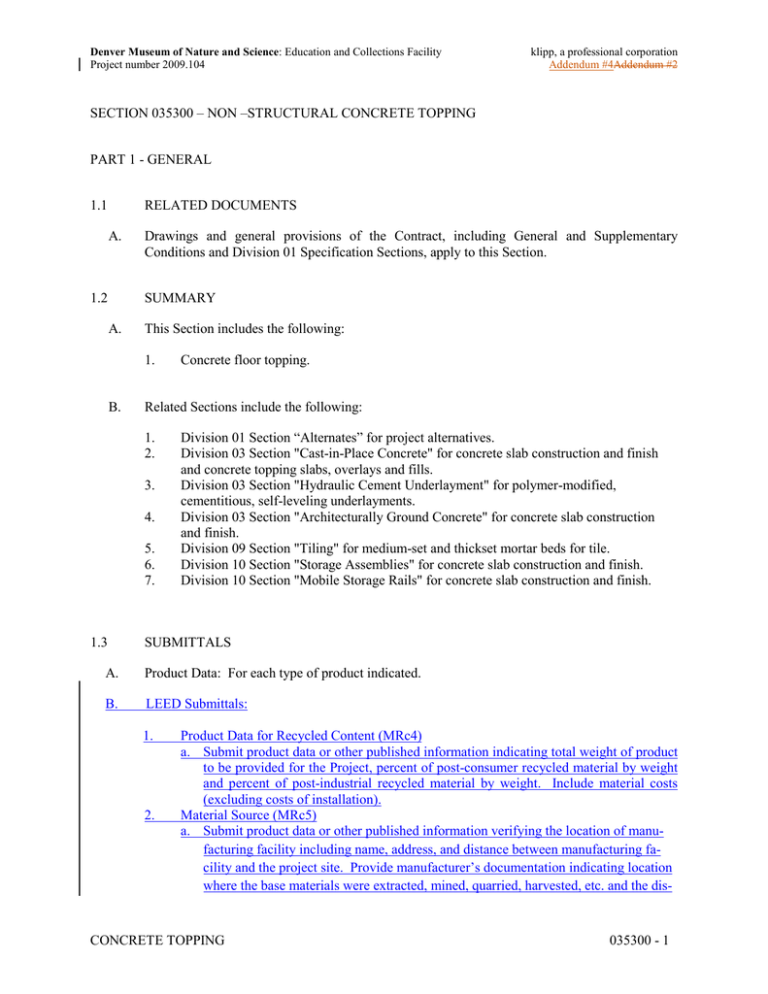
Denver Museum of Nature and Science: Education and Collections Facility Project number 2009.104 klipp, a professional corporation Addendum #4Addendum #2 SECTION 035300 – NON –STRUCTURAL CONCRETE TOPPING PART 1 - GENERAL 1.1 RELATED DOCUMENTS A. 1.2 Drawings and general provisions of the Contract, including General and Supplementary Conditions and Division 01 Specification Sections, apply to this Section. SUMMARY A. This Section includes the following: 1. B. Related Sections include the following: 1. 2. 3. 4. 5. 6. 7. 1.3 Concrete floor topping. Division 01 Section “Alternates” for project alternatives. Division 03 Section "Cast-in-Place Concrete" for concrete slab construction and finish and concrete topping slabs, overlays and fills. Division 03 Section "Hydraulic Cement Underlayment" for polymer-modified, cementitious, self-leveling underlayments. Division 03 Section "Architecturally Ground Concrete" for concrete slab construction and finish. Division 09 Section "Tiling" for medium-set and thickset mortar beds for tile. Division 10 Section "Storage Assemblies" for concrete slab construction and finish. Division 10 Section "Mobile Storage Rails" for concrete slab construction and finish. SUBMITTALS A. Product Data: For each type of product indicated. B. LEED Submittals: 1. 2. Product Data for Recycled Content (MRc4) a. Submit product data or other published information indicating total weight of product to be provided for the Project, percent of post-consumer recycled material by weight and percent of post-industrial recycled material by weight. Include material costs (excluding costs of installation). Material Source (MRc5) a. Submit product data or other published information verifying the location of manufacturing facility including name, address, and distance between manufacturing facility and the project site. Provide manufacturer’s documentation indicating location where the base materials were extracted, mined, quarried, harvested, etc. and the dis- CONCRETE TOPPING 035300 - 1 Denver Museum of Nature and Science: Education and Collections Facility Project number 2009.104 klipp, a professional corporation Addendum #4Addendum #2 tance between this location and the project site. Also include material costs (excluding costs of installation). b. Include information on Material Tracking Worksheets. 3. Adhesive and Sealants (EQc4.1) a. Submit product data or other published information verifying the VOC (Volatile Organic Compound) content is less than or equal to the allowable VOC content established by the governing standard. B.C. Field quality-control test reports. C.D. Design Mixtures: For each concrete mixture. Submit alternate design mixtures when characteristics of materials, Project conditions, weather, test results, or other circumstances warrant adjustments. 1. 2. Indicate amounts of mixing water to be withheld for later addition at Project site. Submit substantiating data for each concrete mix design contemplated for use to the Architect/Engineer not less than four weeks prior to first concrete placement. Data for each mix shall, as a minimum, include the following: a. b. c. d. e. f. g. h. 3. Mix identification designation (unique for each mix submitted). Statement of intended use for mix. Mixture proportions and descriptions. Wet and dry unit weight. Water/cementitious materials ratio. Total air content. Design slump. Intended method of placement in field. Shrinkage testing per ASTM C157. D.E. Product Test Reports: Based on evaluation of comprehensive tests performed by a qualified testing agency for concrete floor toppings. E.F. Minutes of preinstallation conference. 1.4 QUALITY ASSURANCE A. Testing Agency Qualifications: An independent agency qualified according to ASTM C 1077 and ASTM E 329 for testing indicated, as documented according to ASTM E 548. B. Mockups: Place concrete floor topping mockups to demonstrate typical joints, surface finish, bonding, texture, tolerances, and standard of workmanship. 1. 2. Build mockups approximately 100 sq. ft. in the location indicated or, if not indicated, as directed by Architect including saw-cuts and sealant, ground as noted in Division 3 Section "Architecturally Ground Concrete". If Architect determines that mockups do not meet requirements, demolish and remove them from the site and cast others until mockups are approved. CONCRETE TOPPING 035300 - 2 Denver Museum of Nature and Science: Education and Collections Facility Project number 2009.104 3. C. 1.5 klipp, a professional corporation Addendum #4Addendum #2 Approved mockups may become part of the completed Work if undisturbed at time of Substantial Completion. Preinstallation Conference: Conduct conference at Project site to comply with requirements in Division 01 Section "Project Management and Coordination." DELIVERY, STORAGE, AND HANDLING A. Deliver materials in original packages and containers, with seals unbroken, bearing manufacturer's labels indicating brand name and directions for storage, mixing with other components, and application. B. Store materials to comply with manufacturer's written instructions to prevent deterioration from moisture or other detrimental effects. 1.6 PROJECT CONDITIONS A. Environmental Limitations: Comply with manufacturer's written instructions for substrate temperature and moisture content, ambient temperature and humidity, ventilation, and other conditions affecting concrete floor topping performance. 1. B. Place concrete floor topping only when ambient temperature and temperature of base slabs are between 50 and 86 deg F. Close areas to traffic during topping application and, after application, for time period recommended in writing by manufacturer. PART 2 - PRODUCTS 2.1 CURING MATERIALS A. Evaporation Retarder: Waterborne, monomolecular film forming; manufactured for application to fresh concrete. B. Absorptive Cover: AASHTO M 182, Class 2, burlap cloth made from jute or kenaf, weighing approximately 9 oz./sq. yd. when dry. C. Moisture-Retaining Cover: sheet. D. Water: Potable. E. Clear, Waterborne, Membrane-Forming Curing Compound: ASTM C 309, Type 1, Class B, 25 percent solids content, minimum. CONCRETE TOPPING ASTM C 171, polyethylene film or white burlap-polyethylene 035300 - 3 Denver Museum of Nature and Science: Education and Collections Facility Project number 2009.104 2.2 klipp, a professional corporation Addendum #4Addendum #2 RELATED MATERIALS A. Semirigid Joint Filler: Two-component, semirigid, 100 percent solids, epoxy resin with a Type A Shore durometer hardness of 80 per ASTM D 2240. B. Portland Cement: 1. Base Bid and Alternate 10B: ASTM C 150, Type I or II. 50% White Portland Cement 2. Alternate No. 4 and Alternate 10A: ASTM C 150, Type I or II. C. Sand: ASTM C 404, fine aggregate passing No. 16 sieve. D. Water: Potable. E. Acrylic-Bonding Agent: ASTM C 1059, Type II, non-redispersible, acrylic emulsion or styrene butadiene. F. Epoxy Adhesive: ASTM C 881, Type V, two-component epoxy resin, capable of humid curing and bonding to damp surfaces, of class and grade to suit requirements. G. Fiber Reinforcement: 1. Buckeye UltraFiber 500; Buckeye Technologies Inc. 2. Approved Submitted Alternative H. Regional Material Source (MRc5) 1. Building Materials in this section must be extracted, harvested, or recovered, and manufactured and assembled within five hundred (500) miles of the jobsite. I. Low-Emitting Paints and Coatings (EQc4.2) 1. 2.3 Submit product data or other published information verifying the VOC (Volatile Organic Compound) content is less than or equal to the allowable VOC content established by the governing standards. MIXING A. Floor Topping: Mix concrete floor topping materials and water in appropriate drum-type batch machine mixer or truck mixer according to manufacturer's written instructions. PART 3 - EXECUTION 3.1 EXAMINATION A. Examine substrates, with Installer present, for conditions affecting performance of concrete floor topping. CONCRETE TOPPING 035300 - 4 Denver Museum of Nature and Science: Education and Collections Facility Project number 2009.104 klipp, a professional corporation Addendum #4Addendum #2 B. Verify that base concrete slabs comply with scratch finish requirements specified in Division 03 Section "Cast-in-Place Concrete." C. Verify that base slabs are visibly dry and free of moisture. Test for capillary moisture by the plastic sheet method according to ASTM D 4263. D. Proceed with application only after unsatisfactory conditions have been corrected. 3.2 PREPARATION A. Reference: Division 01 Section “Alternates” for project alternatives. B. Roughened Concrete Surface: Mechanically abrade base slabs to produce a heavily scarified surface profile with an amplitude of 1/4 inch. 1. 2. 3. C. Light Broomed Concrete Surface: 1. 2. 3. D. Prepare and clean existing base slabs according to concrete floor topping manufacturer's written instructions. Fill voids, cracks, and cavities in base slabs. Mechanically remove contaminants from existing concrete that might impair bond of floor topping. Saw cut contraction and construction joints in existing concrete to a depth of 1/2 inch and fill with semirigid joint filler. Install joint-filler strips where topping abuts vertical surfaces, such as column pedestals, foundation walls, grade beams, and other locations, as indicated. 1. 2. 3. 3.3 Prepare and clean existing base slabs according to concrete floor topping manufacturer's written instructions. Fill voids, cracks, and cavities in base slabs. Mechanically remove contaminants from existing concrete that might impair bond of floor topping. Saw cut contraction and construction joints in existing concrete to a depth of 1/2 inch and fill with semirigid joint filler. Extend joint-filler strips full width and depth of joint, terminating flush with topping surface, unless otherwise indicated. Terminate full-width, joint-filler strips 1/2 inch below topping surface where joint sealants, specified in Division 07 Section "Joint Sealants," are indicated. Install joint-filler strips in lengths as long as practicable. Where more than one length is required, lace or clip sections together. FLOOR TOPPING APPLICATION A. Start floor topping application in presence of manufacturer's technical representative. B. Existing Concrete: Apply epoxy-bonding adhesive, mixed according to manufacturer's written instructions, and scrub into dry base slabs to a thickness of 1/16 to 1/8 inch, without puddling. Place floor topping while adhesive is still tacky. CONCRETE TOPPING 035300 - 5 Denver Museum of Nature and Science: Education and Collections Facility Project number 2009.104 C. Place concrete floor topping continuously in a single layer, tamping and consolidating to achieve tight contact with bonding surface. Do not permit cold joints or seams to develop within pour strip. 1. 2. 3. D. Screed surface with a straightedge and strike off to correct elevations. Slope surfaces uniformly where indicated. Begin initial floating using bull floats to form a uniform and open-textured surface plane free of humps or hollows. Finishing: Consolidate surface with power-driven floats as soon as concrete floor topping can support equipment and operator. Restraighten, cut down high spots, and fill low spots. Repeat float passes and restraightening until concrete floor topping surface has a uniform, smooth, granular texture. 1. Hard Trowel Finish: After floating surface, apply first trowel finish and consolidate concrete floor topping by power-driven trowel without allowing blisters to develop. Continue troweling passes and restraighten until surface is smooth and uniform in texture. a. b. E. Coat face of construction joint with epoxy adhesive at locations where concrete floor topping is placed against hardened or partially hardened concrete floor topping. Contraction Joints: Form weakened-plane contraction joints with power saws equipped with shatterproof abrasive or diamond-rimmed blades. Cut 1/8-inch- wide joints into concrete floor topping when cutting action will not tear, abrade, or otherwise damage surface and before random contraction cracks develop. 1. 2. 3. 3.4 Finish surfaces to specified overall values of flatness, F(F) 25; and levelness, F(L) 20; with minimum local values of flatness, F(F) 17; and levelness, F(L) 15, and measure within 24 hours according to ASTM E 1155 for a randomly trafficked floor surface. Finish and measure surface so gap at any point between surface and an unleveled freestanding 10-foot- long straightedge, resting on 2 high spots or top of rails and placed anywhere on the surface, does not exceed 1/8 inch. Construction Joints: Construct joints true to line with faces perpendicular to surface plane of concrete floor topping, at locations indicated or as approved by Architect. 1. F. klipp, a professional corporation Addendum #4Addendum #2 Form joints in concrete floor topping over contraction joints in base slabs, unless otherwise indicated. Construct contraction joints for a combined depth equal to topping thickness and not less than one-fourth of base-slab thickness. Construct contraction joints for a depth equal to one-half of concrete floor topping thickness, but not less than 1/2 inch deep. PROTECTING AND CURING A. General: Protect freshly placed concrete floor topping from premature drying and excessive cold or hot temperatures. CONCRETE TOPPING 035300 - 6 Denver Museum of Nature and Science: Education and Collections Facility Project number 2009.104 klipp, a professional corporation Addendum #4Addendum #2 B. Evaporation Retarder: Apply evaporation retarder to concrete floor topping surfaces in hot, dry, or windy conditions before and during finishing operations. Apply according to manufacturer's written instructions after placing, screeding, and bull floating or darbying floor topping, but before float finishing. C. Begin curing immediately after finishing concrete floor topping. Cure by one or a combination of the following methods, according to concrete floor topping manufacturer's written instructions: 1. 2. 3. 3.5 Moisture Curing: Keep surfaces continuously moist for not less than 7 days with water or continuous water-fog spray. Moisture-Retaining-Cover Curing: Cover concrete surfaces with moisture-retaining cover for curing concrete, placed in widest practicable width, with sides and ends lapped at least 12 inches, and sealed by waterproof tape or adhesive. Cure for not less than seven days. Immediately repair any holes or tears during curing period using cover material and waterproof tape. Curing Compound: Apply uniformly in two coats in continuous operations by power spray or roller according to manufacturer's written instructions. Recoat areas subjected to heavy rainfall within three hours after initial application. Maintain continuity of coating and repair damage during curing period. JOINT FILLING A. Prepare and clean contraction joints and install semirigid joint filler, according to manufacturer's written instructions, once topping has fully cured. B. Remove dirt, debris, saw cuttings, curing compounds, and sealers from joints; leave contact faces of joint clean and dry. C. Install semirigid joint filler full depth of contraction joints. Overfill joint and trim semirigid joint filler flush with top of joint after hardening. 3.6 REPAIRS A. 3.7 Defective Topping: Repair and patch defective concrete floor topping areas, including areas that have not bonded to concrete substrate. FIELD QUALITY CONTROL A. Testing Agency: Owner will engage a qualified independent testing and inspecting agency to perform field tests and inspections and prepare test reports. B. Testing Services: Testing and inspecting of completed applications of concrete floor toppings shall take place in successive stages, in areas of extent and using methods as follows: 1. Sample Sets: At point of placement, a set of 3 molded-cube samples shall be taken from the topping mix for the first 1000 sq. ft., plus 1 set of samples for each subsequent 5000 sq. ft. of topping, or fraction thereof, but not less than 6 samples for each day's CONCRETE TOPPING 035300 - 7 Denver Museum of Nature and Science: Education and Collections Facility Project number 2009.104 2. 3. klipp, a professional corporation Addendum #4Addendum #2 placement. Samples shall be tested according to ASTM C 109/C 109M for compliance with compressive-strength requirements. Concrete floor topping shall be tested for delamination by dragging a steel chain over the surface. Concrete floor topping shall be tested for compliance with surface flatness and levelness tolerances. C. Remove and replace applications of concrete floor topping where test results indicate that it does not comply with specified requirements. D. Additional testing and inspecting, at Contractor's expense, will be performed to determine compliance of replaced or additional work with specified requirements. E. Any conflicts or inability for General Contractor to perform the survey will be resolved by a third party with oversight by the owner and architect. The cost of this service would be split by the general contractor and the cabinet installer. END OF SECTION 035300 CONCRETE TOPPING 035300 - 8
